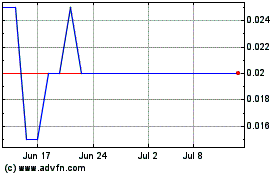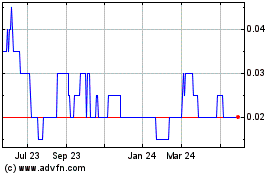BWR Exploration Inc. Confirms Intriguing Nickel and Copper Mineralization at its Wholly-Owned Vendôme Sud Project, Abitibi Region of Quebec
August 11 2021 - 7:59AM

BWR Exploration Inc. (TSX.V: BWR) (“BWR” or the
“Company”) is pleased to announce that four exploratory drill holes
totaling 929 metres of drilling have been completed on its
wholly-owned Vendôme Sud Property, located in the Abitibi Region of
Northern Quebec, located in Fiedmont Township, a few kilometres
west of the town of Barraute, being 30 kilometres north of
Val-d’Or. The property consists of 17 lot claims totaling 712.34
hectares, hosting the historic Vendôme No. 2 Nickel / Copper
mineral occurrence, (aka Mogador) first tested by drilling in the
1960s. The recent drilling by BWR has confirmed that the property
hosts intriguing Nickel-Copper mineralization, warranting further
exploration.
Some of the best historical drill intervals on
the property were reported on the “A Zone” where hole DDH 5-62-5
reportedly intersected 3 feet of 2.65% Ni and 0.65% Cu, while
nearby hole 62-13 reportedly intersected 8.3 feet of 0.9% Ni and
0.47% Cu. BWR completed two holes attempting to replicate and/or
confirm these two holes that were drilled in 1962 by Canadian
Shield Corporation Inc., that partially defined the “A Zone”.
Nearby, (approximately 100 metres north) there was a fairly deep
(150m + +) magnetic anomaly that had been interpreted as a mafic or
ultramafic intrusive, BWR’s third hole explored this geophysical
anomaly to about 200 meters vertical depth. The historical “C Zone”
is located approximately 1 km to the west of the “A Zone” where
drilling in 1963, by Canadian Shield, identified similar
mineralization for the “C Zone” as at the “A Zone”. Canadian Shield
hole C-63-1, according to MERN records, includes a mineralized
interval of 5.5 feet grading 0.77% Ni and 0.65% Cu. BWR completed
one test hole at this location attempting to replicate and/or
confirm the 1963 drill results at the “C Zone”.
Hole BWR-V-21-01
This confirmatory hole was drilled in the
“A-zone” to replicate and/or confirm historic results from DHD
5-62-5 and 62-13. This hole was drilled at a dip of -50 degrees,
bearing 205 degrees (SW) being a similar attitude to hole 62-5
drilled 50 years earlier. This hole intersected several intervals
of copper and nickel sulphides. The drill intersected mineralized
package is described as about 36.5 metres in drill length,
consisting of variably mineralized mafic volcanics (66.8m to
79.8m), weakly mineralized rhyolite (79.8m to 88.9m), variably
mineralized mafic volcanics (88.9m to 103.3m), the hole ended in
relatively poorly mineralized rhyolite at 201 metres. Observed
mineralization includes: chalcopyrite, pentlandite, pyrrhotite,
pyrite with minor sphalerite, confirmed by localized mineralogical
observations supported by a Niton XRF analyzer for base metals. 65
samples were selected for analysis from this hole, assays will be
released once available.
Hole BWR-V-21-02
This confirmatory hole was drilled at a dip of
-60 degrees, bearing 205 degrees (SW) undercutting the previous
hole (BWR-V-21-01). The drill intersected mineralized package is
described as about 40.7 metres in drill core length, consisting of
variably disseminated to semi-massive mineralized ultramafics (82m
to 89.5m), variably mineralized to semi-massive mineralized
rhyolite (89.9m to 117.3m), weak to variably mineralized
ultramafics (117.5m to 122.7m). The hole ended in poorly
mineralized rhyolite at 252 metres. Observed mineralization
includes chalcopyrite, pentlandite, pyrrhotite, pyrite with minor
sphalerite, confirmed by localized mineralogical observations
supported by a Niton XRF analyzer for base metals. 66 samples were
selected for analysis from this hole, assays will be released once
available.
Hole BWR-V-21-03
This exploratory hole was drilled at a dip of
-65 degrees, bearing 220 degrees (WSW), designed to intercept a
geophysically-rendered aeromagnetic high coincident with an excess
mass (gravity) anomaly, akin to an ultramafic intrusive,
interpreted as being related to the well mineralized
mafic-ultramafic lenses observed in holes BW-V-21-01 and 02,
located approximately 100 meters south. This hole intersected a
sequence of mafic (gabbro/peridotite) to ultramafic (komatiite)
volcanics, intercalated with granodiorite and other felsic
intrusives / tuffs and schists (diorite, granodiorite, rhyolite),
ending in a rhyolite tuff at a final drill hole length of 261
meters. Sulphide mineralization was observed to be brecciated and
mostly within quartz-carbonate and carbonate stringers and
veinlets, suggestive of remobilization into the volcanic sequence.
Observed sulphide mineralization includes pyrite, pyrrhotite, as
well as traces of sphalerite, chalcopyrite and pentlandite
(confirmed by Niton XRF analyzer), within brecciated
quartz-carbonate stringers and veinlets, or as fine stringers and
clots within fractures. 84 samples were selected for analysis from
this hole, assays will be released once available.
Hole BWR-V-21-04
Approximately one kilometer to the west of the
“A zone” is the “C zone”. This hole was designed to test historic
“C Zone” mineralization encountered in 1963 drill hole C-63-1 that
included 5.5 feet grading 0.77% Ni + 0.65% Cu, as well as a
conductive high. Hole BW-V-21-04 was drilled at a dip of -45
degrees, bearing 205 degrees (SW). The hole intersected a series of
rhyolite tuffs intercalated and intruded by intermediate to mafic
units, then into an ultramafic assemblage of komatiite and
peridotite. Mineralization in this hole is similar to the
mineralization observed in the first two holes located 100 metres
east, although in hole 21-04, mineralization appears thinner (only
about 6.4 metres) from 97.1 metres – 103.5 metres, with the
strongest mineralization present from 101.2-104.1 metres where
there is 1-5% clotty disseminated sulfide within carbonate
stringers/veinlets as well as occasional semi-massive stringers.
Niton XRF spot testing of the core confirms the presence of Ni, Cu,
Zn and Co in semi-massive sulfide stringers. 107 samples were
selected for analysis from this hole, assays will be released once
available.
Neil Novak (P.Geo.), President of BWR, visited
the project early in the program and met with the project team to
view the first hole together and discuss plans for the next few
holes. Minroc Management Ltd.’s senior geologist Francis R. Newton
(B.Sc.) as project geologist, was tasked with managing this drill
project, working alongside Sahil Alurkar (M.Sc.). Mr. Francis
Newton, P.Geo (OGQ#2129), in collaboration with Mr. Novak are
responsible for and have reviewed the technical disclosure of this
release. Mr. Newton as an independent qualified person pursuant to
NI 43-101 guidelines for technical disclosure, and Mr. Novak as a
qualified person (not independent) pursuant to NI 43-101 guidelines
both approve the technical content of this press release.
BWR Exploration Inc. is a public company focused
on exploring for base and precious metals, with its flagship Little
Stull Lake Gold Project in NE Manitoba along with other exploration
projects in Northern Ontario, and Northern Quebec, Canada.
Management of BWR includes an accomplished group of
exploration/mining specialists with many decades of operational
experience in the junior resource sector in Canada and abroad.
There are 101,442,461 shares currently issued.
Neither the Toronto Venture Exchange nor
its Regulation Services Provider (as that term is defined in the
policies of the TSX Venture Exchange) accepts responsibility for
the adequacy or accuracy of this release.
For more information about BWR’s Vendôme Sud Project please
visit our website:
http://www.bwrexploration.com or call/email:
Neil Novak, P.Geo., President, CEO & Director,BWR
Exploration Inc.82 Richmond St. E Toronto, ON M5C 1P1 Office:
416-848-6866nnovak@bwrexploration.com
For additional information please contact:
Carl DesjardinsParadox Investor Services Inc.Office:
514-341-0408carldesjardins@paradox-pr.ca
BWR Exploration (TSXV:BWR)
Historical Stock Chart
From Dec 2024 to Jan 2025

BWR Exploration (TSXV:BWR)
Historical Stock Chart
From Jan 2024 to Jan 2025
